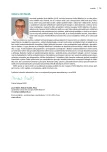Importance of fixed-dose combinations in cardiovascular prevention: the possibility of treating two diagnoses with a single pill
Authors:
Eva Tůmová; Michal Vrablík
Authors‘ workplace:
Centrum preventivní kardiologie, III. interní klinika – klinika endokrinologie a metabolismu 1. LF UK a VFN v Praze
Published in:
Vnitř Lék 2019; 65(12): 809-814
Category:
Overview
In the care of a cardiovascular risk patient there is certainly a more frequent situation in which we try to influence several risk factors at the same time. Treatment of a single self-occurring risk factor is rather an exception. In most cases, we need to intervene with more risk factors, often involving combination therapy, which can achieve the desired goals more quickly and reliably. However, with the number of tablets taken by the patient, the patient’s willingness to take long-term and correct use decreases, which has a significant impact on the effectiveness of therapy and the development of individual cardiovascular risk. In an effort to control all risk factors for cardiovascular disease, there is a growing need to extend the availability of fixed drug formulations to suit the patient’s ease of use and suitably formulated with varying dose grades to meet the needs of our attending physicians. With regard to the fact that early intervention of risk factors brings greater benefits than deferred, we are looking for appropriate ways to manage it. The current intervention of arterial hypertension and dyslipidemia with safe and proven drugs seems to be one of the ways to further improve the results of the prevention of cardiovascular diseases. The new fixed combination of atorvastatin with perindopril, which is entering the Czech market right now, appears to be in many ways an ideal “tablet for cardiovascular prevention”.
Keywords:
hypertension – cardiovascular risk – dyslipidemia – prevention – single pill combination – synergy
Sources
- Yusuf S, Haewken S, Ounpuu S et al. [INTERHEART Study Investigators]. Effect of potentially modifiable risk factors associated with myocardial infarction in 52 countries (the INTERHEART study): case-control study. Lancet 2004; 364(9438): 937–952. Dostupné z DOI: <http://doi: 10.1016/S0140–6736(04)17018–9>.
- Mach F, Baigent C, Catapano AL et al. [ESC Scientific Document Group]. 2019 ESC/EAS Guidelines for the management of dyslipidaemias: lipid modification to reduce cardiovascular risk. Eur Heart J 2019; pii: ehz455. Dostupné z DOI: <http://dx.doi.org/10.1093/eurheartj/ehz455>.
- Nickenig G. Should angiotensin II receptor blockers and statins be combined? Circulation 2004; 110(8): 1013–1020. Dostupné z DOI: <http://doi: 10.1161/01.CIR.0000139857.85424.45>.
- Nickenig G, Harrison G. The AT(1)-type angiotensin receptor in oxidative stress and atherogenesis: Part I: Oxidative stress and atherogenesis. Circulation 2002; 105(3): 393–396. Dostupné z DOI: <http://doi: 10.1161/hc0302.102618>.
- Jozífová M, Cífková R, Lánská V et al. Porovnání léčby hypertenze a rizikového profilu hypertoniků v obecné populaci a na specializovaném pracovišti. Cor Vasa 2003; 45 : 533–541.
- Tropeano AI, Boutouyrie P, Pannier B et al. Brachial pressure-independent reduction in carotid stiffness after long-term angiotensin-converting enzyme inhibition in diabetic hypertensives. Hypertension 2006; 48(1): 80–86. Dostupné z DOI: <http://doi: 10.1161/01.HYP.0000224283.76347.8c>.
- Bruining N, de Winter S, Roelandt JR et al. [EUROPA/PERSPECTIVE Investigators]. Coronary calcium significantly affects quantitative analysis of coronary ultrasound: importance for atherosclerosis progression/regression studies. Coron Artery Dis 2009; 20(6): 409–414. Dostupné z DOI: <http://doi: 10.1097/MCA.0b013e32832fa9b8>.
- Golias Ch, Charalapopoulos A, Stagikas D et al. The kinin systém – bradykinin: biological effects and clinical implications. Multiple role of the kinin systém – bradykinin. Hippokratia 2007; 11(3): 124–128.
- Messerli FH, Bakris GL, Ferrera D et al. [AVALON Investigators]. Efficacy and safety of coadministered amlodipine and atorvastatin in patients with hypertension and dyslipidemia: results of the AVALON trial. J Clin Hypertens (Greenwich) 2006; 8(8): 571–581. Dostupné z DOI: <http://doi: 10.1111/j.1524–6175.2006.05636.x>.
- Hatala R, Pella D, Hatalová K, Šidlo R. Optimization of blood pressure treatment with fixed-combination perindopril/amlodipine in patients with arterial hypertension. Clin Drug Investig 2012; 32(9): 603–612. Dostupné z DOI: <http://doi: 10.2165/11634530–000000000–00000>.
- Sever P, Dahlof B, Poulter N et al. [ASCOT Steering Committee Members]. Potential synergy between lipid-lowering and blood-pressure lowering in the Anglo-Scandinavian Cardiac Outcomes Trial. Eur Heart J 2006; 27(24): 2982–2988. Dostupné z DOI: <http://doi: 10.1093/eurheartj/ehl403>.
- Vrablík M, Freiberger T, Lánská V et al. Projekt Atractiv: zlepšení kardiovaskulární prevence v podmínkách primární péče v České republice. Vnitr Lek 2008, 54(12): 1131–1139.
- Emberson J, Whincup P, Morris R et al. Evaluating the impact of population and high-risk strategies for the primary prevention of cardiovascular disease. Eur Heart J 2004; 25(6): 484–491. Dostupné z DOI: <http://doi: 10.1016/j.ehj.2003.11.012>.
- Chapman RH, Benner JS, Petrilla AA et al. Predictors of adherence with antihypertensive and lipid-lowering therapy. Arch Intern Med. 2005; 165(10): 1147–1152. Dostupné z DOI: <http://doi: 10.1001/archinte.165.10.1147>.
Labels
Diabetology Endocrinology Internal medicineArticle was published in
Internal Medicine

2019 Issue 12
Most read in this issue
- Pharmacologically induced thyreopathy in patients with cardiovascular disease
- Vascular age
- Hypertriglyceridemia and atherosclerosis risk
- Notes on the new “Recommendations for the treatment of dyslipidemia. Influencing of lipids to reduce cardiovascular risk”
